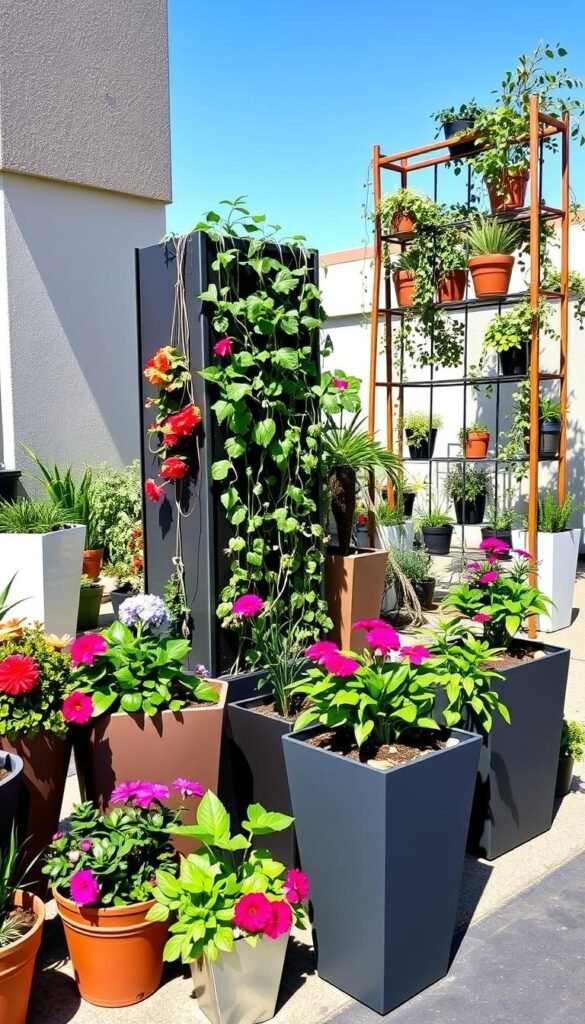Transforming small areas like balconies into vibrant green oases isn’t just possible—it’s surprisingly rewarding. Whether you’re working with a studio apartment ledge or a temporary patio, nurturing plants sparks joy while connecting you to nature. But what happens when it’s time to pack up and move?
Traditional growing methods often fail those who relocate regularly. Heavy pots, fragile arrangements, and deep-rooted greenery become obstacles rather than joys. Imagine creating flexible displays that thrive through every transition—systems designed to move as effortlessly as you do.
This guide reveals innovative strategies for cultivating beauty without permanence. You’ll learn how lightweight materials and smart plant choices let you maintain lush arrangements across multiple homes. We’ll tackle real-world issues like minimizing weight during moves and protecting delicate blooms during transport.
Beyond practicality, these solutions help craft emotional continuity. Your favorite blossoms become traveling companions, turning unfamiliar spaces into personalized sanctuaries. Ready to grow a collection that adapts to your dynamic lifestyle? Let’s dig into the tools and techniques that make it possible.
Understanding the Flexibility of Container Gardening
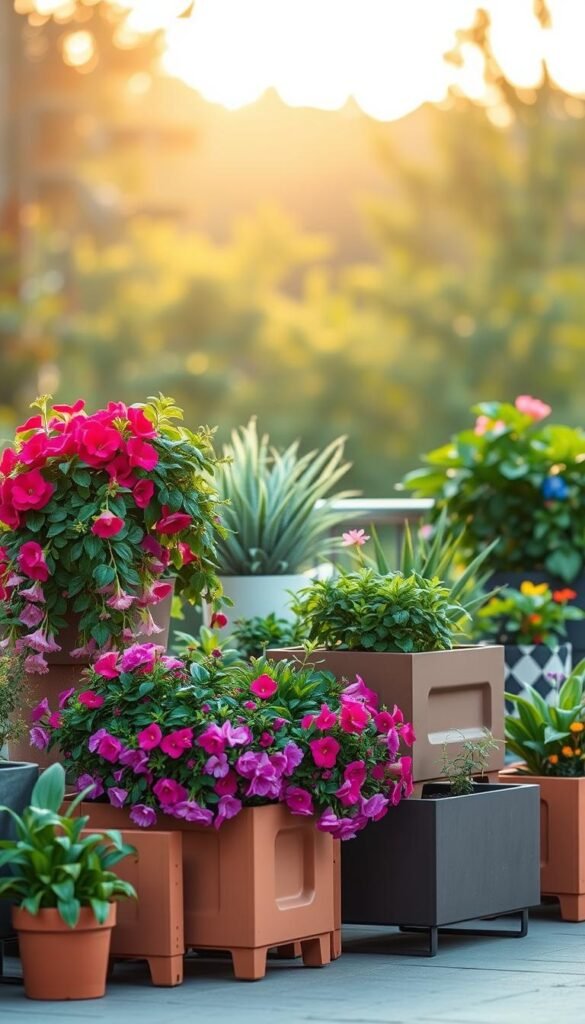
Growing greenery on-the-go transforms limitations into creative opportunities. With movable planters, you control sunlight exposure, spatial layouts, and seasonal adjustments without digging a single hole. This approach turns cramped balconies into thriving ecosystems that evolve with your needs.
Benefits for Dynamic Lifestyles
Lightweight pots let you rearrange plants instantly. Forget about landlord disputes – your displays leave surfaces untouched. One renter transformed a fire escape into a cascading herb haven using stackable planters, proving temporary spaces can burst with life.
Adapting to Any Environment
Your living area changes? So does your garden. Compact succulents thrive on narrow ledges, while trailing vines soften concrete corners. Rotate citrus trees toward sunlight in winter, then shift ferns to shaded nooks during summer heatwaves.
| Features | Container Displays | Traditional Gardens |
|---|---|---|
| Relocation Ease | Move entire setups in minutes | Root systems anchor plants |
| Space Adaptation | Fits 3 sq.ft balconies | Requires dedicated ground area |
| Lease Compliance | Zero permanent changes | Often prohibited |
Urban dwellers report 68% higher satisfaction when using modular systems compared to fixed plots. The secret? Your green companions grow with you, not despite your mobile lifestyle.
Container Flower Garden Hacks: Portable Displays for Renters and Frequent Movers
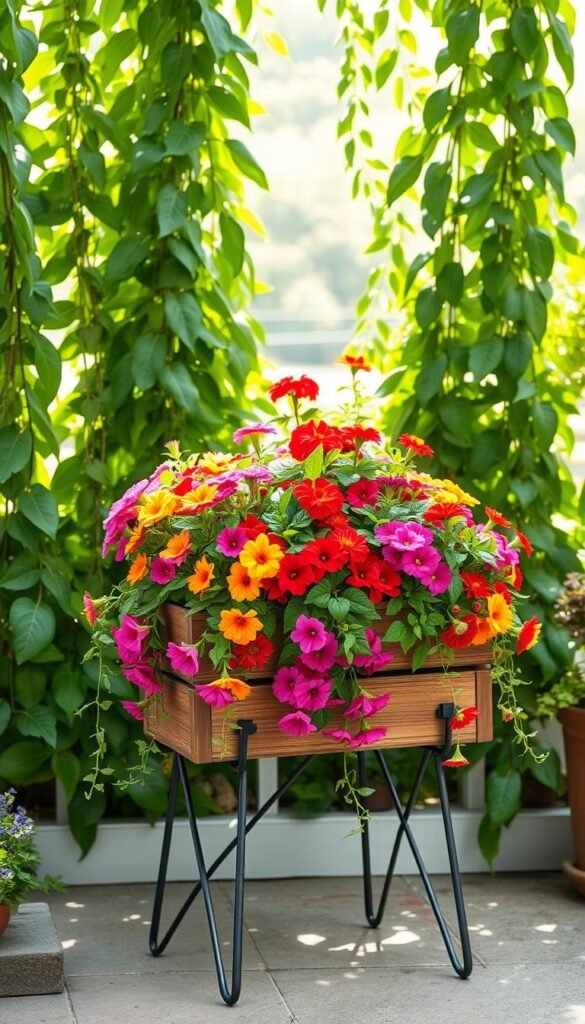
Creating a thriving green area that moves with you starts with strategic planning. Weight concerns and lease agreements demand clever solutions that traditional gardening can’t provide. Let’s explore how to build arrangements that adapt as quickly as your life changes.
Why Portability Matters in Your Garden Design
Building codes often restrict balcony loads to 50 pounds per square foot. That decorative ceramic urn? It might weigh 30 pounds empty. Add soil and water, and you’ve breached limits before adding plants. Property manager Lisa Chen notes: “Tenants often underestimate how quickly potted displays add up. Lightweight setups prevent structural issues and deposit disputes.”
Choosing Materials That Stay Light and Durable
Modern materials solve the heavy pot dilemma. Fiberglass mimics stone aesthetics at 70% less weight. Fabric grow bags fold flat during moves while promoting healthier roots. Consider these comparisons:
| Material | Weight (Empty) | Weather Resistance | Lifespan |
|---|---|---|---|
| Plastic | 1-3 lbs | High | 5+ years |
| Fiberglass | 4-8 lbs | Excellent | 10+ years |
| Fabric | <1 lb | Moderate | 3-5 years |
Stackable designs save space during transitions. Look for built-in handles or wheels—these features cut moving time by half according to urban gardening surveys. Your balcony becomes a modular studio where every element serves multiple purposes.
Choosing the Right Lightweight Plant Containers
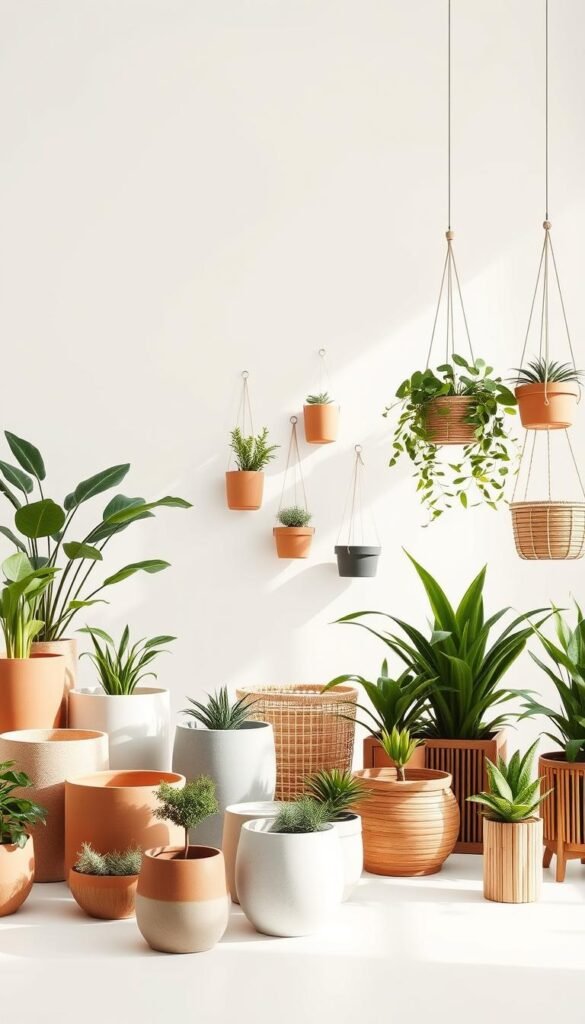
What makes a planter truly move-friendly? It’s not just about weight—it’s how materials and design work together to support your lifestyle. The best options balance durability with features that simplify relocation and plant care.
Exploring Plastic, Fiberglass, and Fabric Options
Plastic pots shine for budget-conscious growers. Modern designs mimic stone textures while weighing 80% less. Look for UV-resistant varieties that won’t fade on sunny patios.
Fiberglass planters offer premium durability. They handle extreme temperatures without cracking—perfect for citrus trees or roses needing year-round stability. One urban gardener reported her fiberglass set lasting through seven moves!
Don’t overlook fabric grow bags. These foldable wonders promote air-pruned roots, reducing transplant shock. Their handles make carrying soil-filled units easier than traditional clay pots.
Features That Enhance Portability and Drainage
Smart design details transform ordinary planters into mobile powerhouses. Built-in wheels let you shift heavy arrangements effortlessly. Self-watering reservoirs keep moisture consistent during busy weeks.
Drainage matters more than you think. Saucers protect surfaces, while mesh-lined holes prevent soil loss. One study showed plants in well-drained pots grow 40% faster than those in waterlogged containers.
| Feature | Benefit | Best For |
|---|---|---|
| Integrated handles | Easy lifting | Fabric & plastic |
| Stackable design | Space efficiency | Modular systems |
| Dual drainage layers | Root protection | Moisture-sensitive plants |
Prioritize multipurpose sizes—a 12-inch diameter works for tomatoes and dwarf shrubs. As landscape designer Marco Torres advises: “Versatile planters adapt as your green thumb evolves.”
Designing Your Space with Versatile Garden Solutions
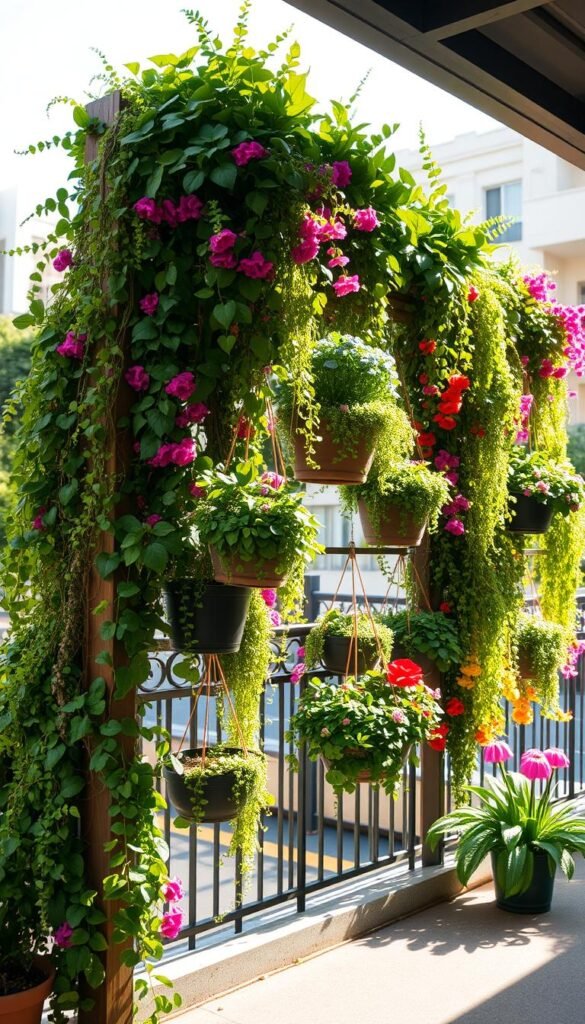
Elevate your green thumb game by reimagining unused surfaces. Vertical gardening lets you grow upwards instead of outwards, perfect for tight quarters where every inch counts. This approach turns blank walls into blooming masterpieces while keeping your setup mobile.
Maximizing Limited Areas on Balconies and Patios
Railings become prime real estate with clamp-on planters. Attach lightweight pots to metal bars using adjustable brackets—no drilling required. One New Yorker grew 14 herb varieties on a 4-foot ledge this way. Overhead hooks? Perfect for trailing ivy or cherry tomatoes.
Integrating Vertical Gardening Techniques
Modular trellis systems let climbing plants like jasmine create natural privacy screens. These foldable grids attach with removable straps. As urban gardener Tasha Reyes notes: “My pea plants survived three moves thanks to portable supports. They’re like green room dividers!”
| Vertical Solution | Space Saved | Best Plants | Installation Time |
|---|---|---|---|
| Wall-mounted planters | 80% floor area | Herbs & succulents | 15 minutes |
| Hanging baskets | 100% ground space | Ferns & petunias | 5 minutes |
| Tiered stands | 65% footprint | Vegetables & flowers | 10 minutes |
| Modular trellis | 90% wall coverage | Climbing vines | 20 minutes |
Pocket planters transform fences into living art. These fabric pouches hold soil while draining excess water. Try mixing colorful pansies with aromatic lavender for visual and sensory appeal. Your balcony becomes a multi-level oasis that travels well.
Remember—stackable units simplify moves. A three-tier stand breaks down into flat panels, while fabric wall gardens roll up like yoga mats. These smart designs let you take your green sanctuary wherever life leads.
Low-Maintenance Plants and Smart Gardening Tips
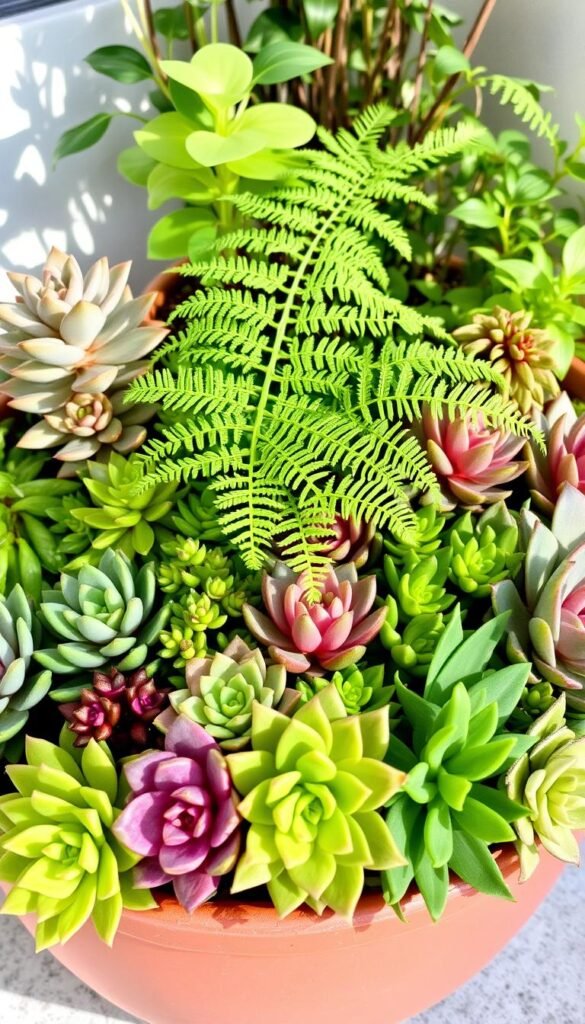
Building a thriving green space becomes effortless when you partner with nature’s toughest performers. Certain species flourish with minimal intervention, letting you enjoy vibrant foliage and blooms even during hectic life transitions.
Selecting Succulents, Herbs, and Climbing Varieties
Succulents like echeveria and sedum store water in their leaves, surviving weeks without attention. Pair them with cacti for textural contrast—these spiky friends thrive in bright sunlight and sandy soil mixes. Urban gardener Mia Torres shares: “My jade plant collection has moved cross-country twice. They’re practically travel-sized!”
Herb gardens pull double duty as kitchen aids and aromatic decor. Rosemary and thyme handle dry spells better than basil, making them ideal for forgetful waterers. Cluster pots near sunny windows for quick snips while cooking.
| Plant Type | Water Needs | Light Preferences | Care Tip |
|---|---|---|---|
| Succulents | Every 2-3 weeks | Direct sunlight | Use gritty soil mix |
| Herbs | Weekly | 4-6 hours sun | Trim regularly |
| Climbing Plants | Moderate | Indirect light | Provide moss poles |
Vertical growers like pothos adapt to various conditions. Their trailing vines mask bland walls while improving air quality. Group climbing plants with similar water requirements to streamline care. A Boston fern paired with philodendron creates a lush corner with just weekly misting.
Remember—hardy varieties like snake plants tolerate low light during moves. Their sword-like leaves add structure to spaces while filtering toxins. With smart choices, your green companions become resilient partners in every chapter of life.
Portable Garden Ideas for a Moving Lifestyle
Cultivating flavor wherever you live starts with rethinking traditional approaches. Mobile herb setups let you harvest fresh ingredients without being tied to one spot—perfect for those who value flexibility as much as freshness.
Practical Strategies for Setting Up a Mobile Herb Garden
Start with culinary essentials like basil, parsley, and chives. These thrive in compact pots and adapt to shifting light conditions. Cluster them in lightweight crates that slide from kitchen counters to sunny windowsills effortlessly.
Mix in dwarf veggies like cherry tomatoes for added versatility. Their shallow roots handle container life beautifully. Pair with self-watering pots to simplify hydration—ideal when your water source is a bathroom sink.
Design themed clusters for quick moves. An Italian trio (oregano, thyme, rosemary) travels as one unit, while mint and chamomile create a tea station. Rotate these groups based on season or living space layout changes.
For more ideas on maximizing small outdoor areas, explore our guide to patio setups. These gardening solutions prove even temporary spaces can burst with life—no permanent footprint required.
Your green oasis grows with you, turning every home into a personalized sanctuary. With smart plant choices and adaptable containers, freshness stays within arm’s reach—no matter where life plants you next.

